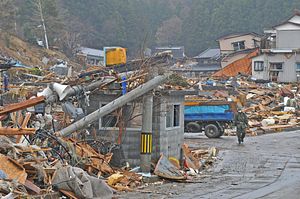Japan has continued its leadership role in the area of disaster preparedness by successfully hosting the Third UN World Conference on Disaster Risk Reduction in Sendai from March 14-18, 2015. This conference concluded with the adoption of the Sendai Framework for Disaster Risk Reduction 2015-2030, which emphasised resilience, sustainability and understanding disaster risk. It did not, however, take the opportunity to fully incorporate the experiences of Japan’s “triple disaster” of 2011.
In the case of disaster risk reduction, there was perhaps actually less to talk about at Sendai than what may first have appeared to be the case. When it comes to natural disasters, we have a pretty good idea what to do. Money spent on prevention goes much further than when spent after a disaster has occurred. Education plays a critical role in giving people the tools necessary to know how to respond when a disaster strikes. Certain parts of the population are acutely vulnerable after a disaster, such as the elderly and the disabled, and disaster planning and response needs to take into account these differences. Gender is another important variable: Women tend to suffer more from disasters than men. More generally, pre-existing vulnerabilities in a society are reinforced and exacerbated following a disaster. On the whole, the problem is not knowing what to do, it is actually doing it. As the 2015 Global Assessment Report on Disaster Risk Reduction recently observed, there needs to be less rhetoric and more action.
One area where there still is room for improving best practice is in preparing and responding to “natech” disasters, situations where a natural hazard triggers a technological disaster. These are especially challenging because of their complex and nonlinear nature, which may render existing response plans and emergency infrastructure ill-equipped to deal with an unexpected set of events. The growing risk posed by natech disasters was partly reflected in the inclusion at Sendai of a working session on technological hazards, although little on the topic made it into the final framework.
The most significant recent example of this type of natech disaster was the 2011 nuclear accident at Fukushima Daiichi power plant, which was triggered by the massive earthquake and tsunami. Unfortunately Japan missed the chance to take the lead on addressing the risks posed by such hazards, choosing to downplay the nuclear accident during proceedings in Sendai. As the Japan Times observed, in his address to the Sendai conference “Prime Minister Shinzo Abe had little to say on the tsunami-triggered core meltdowns in Fukushima.” Nonetheless, there were a number of well attended side events on the nuclear accident, with many participants expressing their frustration that Fukushima was not accorded a more prominent role at Sendai.
It is perhaps understandable why Japan preferred to downplay the nuclear accident, given the many political and institutional failures that led to and exacerbated the disaster. Yet reflecting on the experiences of Fukushima, and incorporating them into future disaster risk reduction planning, is of great importance precisely because it represents the kind of disaster we are more likely to encounter.
The combination found at Fukushima Daiichi of aging infrastructure interacting with a natural hazard to trigger a technological disaster is a scenario that is likely to become increasingly common in the future. As a result of climate change, extreme weather events are becoming more severe and more common. This leaves existing technological infrastructure increasingly at risk, as the hazards now exceed the assumptions on which this infrastructure was designed. Simply put, much existing infrastructure was not designed for the “new normal” that is resulting from climate change, which means there is a much greater risk of technological disasters becoming a common accompaniment to natural disasters.
The Fukushima nuclear accident was marked by major problems with evacuation, information provision, and communication. Evacuation procedures broke down and were completed haphazardly, resulting in some people being exposed to more radiation than if they had not moved in the first place. Affected residents lacked fuel to escape; meanwhile there were insufficient buses and escape routes as well as problems due to damaged roads and infrastructure. As the nuclear crisis worsened, some organizations withdrew their staff, while many private sector actors refused to enter into the area, which compounded problems with getting basic necessities to affected residents.
There has been a strong path dependency with the Fukushima disaster, with decisions made during the initial response period having a determinative impact on the subsequent recovery process. In particular, problems with the way evacuations were handled and information was conveyed to the public led to a breakdown of trust between affected residents and the government and Tokyo Electric Power Company (TEPCO) officials. Trust takes a long time to build, but it can be lost very quickly. This, in turn, has made the recovery process much more challenging, because affected people understandably remain very sceptical of official assurances that radiation levels are safe.
Understandably the Fukushima Daiichi accident has triggered a renewed focus on the dangers of operating nuclear power, but this experience has much wider applicability. Next time it may not be a nuclear plant, it could instead be a chemicals factory or an oil refinery, and the results could be potentially far more devastating. In this regard, the recent thirty year anniversary of the Bhopal gas tragedy, which resulted in at least 3,787 deaths and more than 550,000 injuries, offers a powerful reminder of the possible dangers societies face.
Quite simply, Fukushima is a future we need to better prepare for.
Christopher Hobson is an assistant professor of political science at Waseda University, and a visiting research fellow at United Nations University, where he is contributing to the Fukushima Global Communications Programme. You can follow him on Twitter at: @hobson_c

































